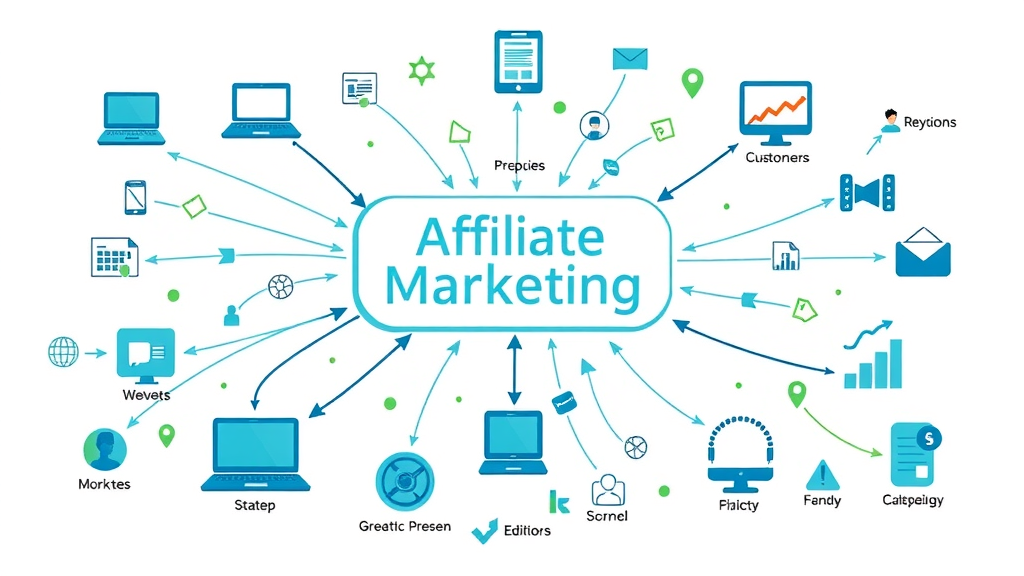Is your dream of earning passive income steering you toward true financial freedom — or setting you up for disappointment? The debate of affiliate marketing vs mlm is more relevant than ever, and your path to sustainable online income hinges on understanding the critical distinctions, misconceptions, and potential traps in each model. This comprehensive guide equips you with everything you need to separate fact from fiction and make confident, informed decisions.
Are Your Dreams of Passive Income Leading You Down the Right Path?
- Why the affiliate marketing vs mlm debate matters for your financial future
- How common misconceptions can trap beginners in risky business models

What You Will Discover About Affiliate Marketing vs MLM
- Clear distinctions between affiliate marketing and network marketing strategies
- Warning signs of pyramid schemes and false promises
- Fact-based insights to empower smart business decisions
Understanding Affiliate Marketing vs MLM: Defining the Terms
What Is Affiliate Marketing? How Does It Work?
Affiliate marketing is a popular online business model where individuals, known as affiliate marketers, promote products or services on behalf of companies. By sharing special affiliate links through their website, blog, social media, or email list, affiliate marketers earn commissions whenever someone clicks their link and completes a purchase or action. Unlike direct sales or multi level marketing, affiliate marketers do not have to handle product inventory, customer service, or recruit a team. Their income is typically based on the performance of their marketing strategy and the quality of leads or sales that they generate for their advertising partners.
The beauty of affiliate programs lies in their flexibility: anyone can sign up for free or for a nominal fee, choose from thousands of products or services, and build an income stream without ever needing to pressure others into joining. Top affiliate networks like Amazon Associates, ShareASale, and Commission Junction make tracking sales and receiving payouts automated and transparent. With consistent effort and smart content, you can earn commissions as your online presence grows.

What Is MLM (Multi Level Marketing)? Core Principles of Network Marketing
Multi level marketing (MLM) is a business model that combines elements of direct sales with team-based commission structures. In an MLM program, participants earn money not just by selling products and services, but by recruiting new members into the network marketing hierarchy beneath them. This recruitment process — forming levels of "downlines" — is central to how most MLM companies function. Each sale and each new recruit generates a percentage of profits that flows up the ladder to those at higher levels.
While network marketing can, in some rare cases, result in substantial payouts for early and aggressive participants, the vast majority of mlm participants experience low earnings. Many MLM business models require upfront investments in starter kits or monthly product purchases. The pressure to recruit friends, family, and acquaintances can lead to strained relationships and financial risk if the structure resembles a pyramid scheme . Laws exist to regulate MLM programs, but grey areas remain, making due diligence critical.
Affiliate Marketing and MLM: Overlapping Strategies and Key Differences
Both affiliate marketing and MLM use strategies such as product recommendations, content creation, and marketing through digital channels, but the similarities mostly end there. The key differences revolve around compensation, risk, and business model transparency. Affiliate marketers earn commissions solely on actual product sales or leads—the emphasis is on the value delivered to a merchant or advertiser. In contrast, MLM business models reward recruitment often more than product sales. This can blur the line with pyramid schemes where most profits are tied to enrolling others, not retailing goods.
Regulations draw a clear line: legal affiliate programs are performance-driven and product-centric, while questionable MLMs focus heavily on recruitment and continuous personal buying. It's precisely these differences that can make the affiliate marketing vs MLM debate confusing to beginners, increasing the risk of falling into a problematic scheme.
| Aspect | Affiliate Marketing | MLM (Multi Level Marketing) |
|---|---|---|
| Compensation | Earn commissions from sales or leads, no recruitment required. | Earnings from product sales and team recruitment (downlines). |
| Upfront Costs | Usually free or low barrier to join. | Often involves buying starter kits or monthly quotas. |
| Risk Level | Lower risk, focused on marketing performance. | Higher risk, possibility of losing investment if not recruiting. |
| Legal Status | Generally safe if transparent and performance-based. | Heavily regulated; risk of resembling a pyramid scheme. |
| Recruitment Emphasis | None | Core to compensation. |
Decoding Business Models: Affiliate Marketing Programs vs Multi Level Marketing
How Affiliate Programs Operate in Real Markets
Genuine affiliate programs act as a bridge between brands (or networks) and the independent affiliate marketers who promote their products. The process is simple: an affiliate marketer signs up, receives unique affiliate links, and earns a commission for every successful referral or sale tracked to their link. Most affiliate programs provide marketers with analytics dashboards, reporting tools, and creative assets to fuel their campaigns. Transparency and data-tracking are the foundation of trust in this business model, with clear terms on how and when commissions are paid out.
Affiliate marketing flourishes in social media, blogging, email lists, and comparison sites within nearly every vertical imaginable—fintech, travel, fashion, SaaS, and more. The business model relies on delivering value to end consumers and to brands seeking fresh customers. It rewards innovation, strong marketing strategies, and ethical promotion: a win-win for companies and affiliates alike.

The Multi Level Marketing (MLM) Structure Explained
The core engine of an MLM program is its compensation structure: not only do you (the distributor) profit from selling products, but you also build a network ("downline") of additional marketers. You can receive commissions on their sales—and on the team they build beneath them. As the organization grows, so do the potential payouts, but only for those near the top. This multi-layered structure creates strong incentive for constant recruitment, often overshadowing the sales of products themselves.
Most reputable MLM companies offer real products or services and provide scripts, training, and marketing materials. However, when commissions heavily favor recruitment over actual product sales, regulatory agencies (like the FTC) may label such an mlm business a pyramid scheme . These programs are risky because the lowest tiers—where most people land—usually see minimal returns, and upfront investments can be lost if recruitment stalls.
Common Pitfalls of Each Business Model (With Examples)
In affiliate marketing, common pitfalls include joining programs that don’t pay out, promoting scammy offers, or violating advertising guidelines on social media platforms, which can result in lost commissions or banned accounts. Some marketers fail to read the fine print on how conversions are tracked, leading to disputes over uncredited sales.
In MLM, the biggest trap is overinvesting in inventory or joining programs that promise “passive income” through recruitment but don’t focus on genuine product sales. The pressure from upline members to continually recruit can lead to nagging friends, wasting money, and participating in ethically grey, even illegal, businesses. The line between network marketing and pyramid scheme can be thin—so the need for research and caution cannot be overstated.
"In affiliate marketing, your earnings depend on sales or leads. In MLM, your income often hinges on team recruitment — beware the pyramid scheme."
Is It Legal? Regulatory Considerations for Affiliate Marketing vs MLM
The Role of Pyramid Schemes in Network Marketing
Regulatory agencies worldwide strictly monitor multi level marketing to protect consumers from pyramid schemes . A classic pyramid scheme pays more for recruitment than for product sales, often requiring continuous new signups to sustain payouts. Such models collapse when recruitment slows, leaving most participants with losses. Regulators like the FTC frequently sue mlm companies that cross the line, and red flags include mandatory high inventory purchases, vague compensation promises, and little actual retail sales.

How Affiliate Marketing Avoids (or Risks) Legal Trouble
Affiliate marketing is legal as long as all offers are genuine, advertising is accurate, and partners follow regulations such as disclosing affiliate relationships per FTC guidelines. Problems arise if affiliates use deceptive practices, such as fake testimonials, hidden charges, or endorse scam products. By choosing reputable brands and being transparent about commissions, affiliate marketers significantly reduce their legal risk.
- Red flags and due diligence: Look out for offers requesting upfront fees, vague compensation plans, or lack of a clear end product—these can signal a scammy affiliate network or a disguised pyramid scheme.
Earning Potential: Can You Build Real Passive Income with Affiliate Marketing or MLM?
Typical Earnings from Affiliate Programs
Typical earnings from affiliate programs vary widely by niche, audience size, and chosen marketing strategy. Most new affiliate marketers might start with a few dollars a week, but with experience and high-traffic channels, earning $100, $500, or even $10,000+ monthly is possible. Success comes from selecting reputable programs, refining your content, leveraging SEO and social media, and scaling up over time. It's important to note that, despite talk of “easy money” and passive income , sustainable affiliate marketing requires consistency, learning, and regular effort—at least in the beginning.

Multi Level Marketing: Success Rates and Average Income
Industry data consistently shows that the vast majority of mlm participants earn little to nothing beyond their initial investment. Only a tiny fraction at the top of the network earn significant commissions, mainly from the purchases and recruitment efforts of their downlines. According to the FTC and research on mlm programs, over 99% of participants actually lose money. While enthusiastic network marketers share big checks on social media, these outliers are exceptions, not the rule. MLM companies often require minimum product purchases or monthly quotas that can eat into profits and incentivize inventory loading over real product sales.
Passive Income Myths in Marketing and MLM
The promise of passive income is a major draw for both affiliate marketing and Multi Level Marketing, but it’s often misunderstood. In reality, true passive income—where you earn money with little or no ongoing effort—is rare. In affiliate marketing, earnings can become passive once you’ve built good content that keeps attracting customers. But this typically follows months (or years) of consistent work. In MLM, “passivity” is exaggerated: ongoing sales and constant downline recruitment are usually required to maintain your income and rank. Always be wary of any program that guarantees easy, effortless riches.
The Affiliate Pro’s Guide: Evaluating Opportunities and Protecting Yourself
Essential Questions to Ask Before You Join Any Affiliate Program or MLM
Before joining any affiliate program or mlm opportunity, ask these crucial questions: Is the program transparent about fees, commissions, and product quality? Is recruitment or product sales the primary revenue source? Does the company have positive third-party reviews or unresolved complaints? Can you cancel at any time without penalty? Do they follow legal disclosure requirements for marketing partnerships? These questions help you avoid scams, protect your investment, and focus on resilient business models.
- Does the company provide real products or services people want to buy outside the network?
- Is your main income potential from sales or recruiting others?
- Are the compensation and payout terms clear and written?
- Are there refund and cancellation policies?
- Is there any regulatory scrutiny or negative industry publicity?

The Best Tools & Platforms for Safe Affiliate Marketing
Top affiliate marketers rely on proven tools for tracking, automating, and optimizing campaigns. Platforms like ShareASale, ClickBank, Rakuten, and Amazon Associates offer secure, scalable affiliate networks with robust analytics. Trusted WordPress plugins, email marketing services, and SEO optimization tools help streamline content creation and link management. Always check platform payment reliability, support responsiveness, and compliance with advertising guidelines before investing your efforts.
Leverage marketing and mlm forums, reviews, and compliance resources to stay updated on unethical programs or industry news. Collaboration with other affiliate pros can uncover hidden pitfalls and expose dangerous trends before you get burned. Remember, if an opportunity sounds too good to be true, it probably is.
Analyzing Marketing and MLM: Trends, Shifts, and Industry Insights
The Rising Popularity of Affiliate Marketing Programs
In recent years, affiliate marketing programs have experienced explosive growth, driven by the rise of e-commerce, the gig economy, and the dominance of digital platforms. Brands increasingly prefer affiliate network strategies for customer acquisition over expensive, traditional advertising. The low cost, high scalability, and performance-driven nature of affiliate marketing make it an ideal fit for both solo entrepreneurs and established companies. This trend is forecast to continue as more marketers and creators turn to affiliate links, social media, and content-based promotion for supplemental or full-time online income.

Why MLMs Are Adopting Affiliate Program Techniques
Facing negative press and regulatory scrutiny, many MLMs are attempting to legitimize their image by borrowing affiliate marketing strategies. This includes offering direct sales “affiliate” options, shifting focus away from mandatory recruitment, and leveraging online tools for sales tracking. These hybrid models may come with lower entry costs and attempt to attract a new generation of marketers. However, the core compensation plan often still rewards recruitment, so it’s important for would-be network marketers to read the fine print.
Future of Marketing and MLM: What to Watch For
The future of online marketing will likely see the further blending of affiliate marketing and network marketing tactics, with regulatory bodies cracking down harder on exploitative schemes. Affiliate programs will keep investing in technology, compliance, and user-friendliness—raising the bar for transparency and reliability. Meanwhile, legitimate MLMs will need to pivot toward customer-centric models to survive, putting real retail sales ahead of recruitment. For those seeking passive income in the digital economy, choosing evidence-based, transparent programs will be key to sustainable success.
"The surest path to disappointment is equating multi level marketing with real affiliate marketing. The differences are as real as the risks."
Which is Better, MLM or Affiliate Marketing? (Expert Insights)
Key Metrics: Comparing Outcomes for Affiliate Marketing vs MLM
When comparing key outcomes, the data is clear. Most affiliate marketers have more control, transparency, and growth opportunities than those in MLM businesses. High-traffic websites can scale affiliate marketing with minimal overhead, while MLM models usually demand constant team-building and inventory management. Affiliate programs are measured by click-through and sales conversion rates, and top performers enjoy passive income as their content matures. In contrast, MLM participants must keep recruiting to maintain status, and most never recoup their initial investment, let alone profit.
Reasons to Choose Affiliate Marketing Over Network Marketing
Choosing affiliate marketing over network marketing offers numerous advantages: less risk, greater independence, and no need for constant recruitment or inventory. The best affiliate programs are free to join, require little to no capital, and let you focus on selling products and services you personally believe in. Transparent reporting, on-demand payouts, and flexible schedules make affiliate marketing especially appealing to those seeking genuine, scalable income streams.
- Pros and cons recap: affiliate marketing vs mlm

Practical Examples: Starting with Affiliate Marketing vs MLM
How to Launch Your First Affiliate Marketing Campaign
To start in affiliate marketing, choose a profitable niche and sign up for reputable affiliate programs —like Amazon, ShareASale, or Rakuten. Next, build an audience with high-quality content (blogs, YouTube, TikTok, or Instagram), integrating your affiliate links where they offer genuine product recommendations. Use analytics to optimize for conversions, and scale your reach with SEO and social media promotion.
Consistency and authenticity are vital—your audience needs to trust your opinions and know when you are earning commissions. Experiment with different marketing strategies and move on from offers that underperform. Over time, as your digital assets rank and attract more eyeballs, commissions can snowball, giving you a more passive income stream.
Joining a Multi Level Marketing Program: What to Expect
If considering multi level marketing, brace for high-pressure sales pitches about “ground-floor” opportunities and the promise of substantial residual income. You'll likely need to purchase a starter pack or monthly inventory, attend trainings, and focus on recruiting. Success often depends more on your ability to sign up new members than on selling products to real customers. Your time, money, and social capital will be tested. Know that very few new mlm participants see lasting profits; proceed with extreme caution and clear eyes.
Case Studies: Successes & Failures in Affiliate Marketing and MLM
Consider Jane, a digital content creator and affiliate marketer, who researched lucrative programs, focused on SEO, and built a trustworthy review site. Her commissions steadily grew, and after two years, her affiliate income exceeded her 9-to-5 salary. In contrast, Mike joined an MLM program, investing thousands into inventory he couldn’t sell. Pressure to recruit strained friendships, and within a year, he abandoned the business with a financial loss.

People Also Ask: Affiliate Marketing vs MLM Explored
Which is better, MLM or affiliate marketing?
- Affiliate marketing typically offers greater transparency, flexibility, and earnings potential without recruitment pressures, unlike most MLM structures where only a small percentage profit.
Can you make $100 a day with affiliate marketing?
- Yes, with the right strategy and effort, earning $100 a day from affiliate marketing is possible, though it requires selecting reputable programs, consistent content, and effective promotion.
Is there anything illegal about affiliate marketing?
- Affiliate marketing is legal when conducted ethically and in accordance with advertising guidelines. Problems arise only when deceptive practices or scam offers are involved.
Why are MLMs going to affiliate marketing?
- MLMs are adopting affiliate programs to broaden their reach, reduce legal scrutiny, and leverage online channels, moving away from direct recruitment to product-selling models.

Frequently Asked Questions About Affiliate Marketing vs MLM
- What is the biggest myth about affiliate marketing vs mlm?
- Can you legally promote network marketing without risk?
- Can you combine affiliate marketing and mlm for increased income?
- Are the best affiliate programs safer than even the most reputable mlms?
Common Pitfalls to Avoid When Choosing Affiliate Marketing vs MLM
How to Detect Pyramid Schemes Disguised as Affiliate Programs
Beware of any “affiliate program” that requires high upfront payments, emphasizes recruiting over genuine product sales, or offers vague details about the underlying business. Pyramid schemes often masquerade as affiliate marketing but lack real products or services of value—your income comes from signing up new participants, not from customer demand.
Why Overpromising Income Is a Red Flag in Multi Level Marketing
Genuine business models do not guarantee high, instant income with little effort. Be wary of any MLM program making such claims, or pushing videos and testimonials showing large checks with no mention of risk, effort, or ongoing costs. Overpromising is a marketing strategy to lure in inexperienced network marketing hopefuls and often masks the reality of low average earnings.
- Failing to research the program and check reviews
- Believing hype over data and verified earnings statements
- Ignoring legal and regulatory warnings about specific companies
- Investing more money than you can afford to lose
- Relying solely on recruitment, not product sales or marketing

"Smart marketers know the difference between scalable affiliate programs and high-risk multi level marketing — your wallet should too."
Key Questions to Assess Before Joining Affiliate Marketing or MLM
- Is there a legitimate product or service in demand by real customers?
- Are earnings primarily based on product sales (not recruitment)?
- Are fees, compensation, and terms clear and up front?
- Can you see independent reviews and industry ratings?
- Does the company have a history of legal action or warnings?
Summary: How to Succeed with Legitimate Affiliate Marketing vs MLM Opportunities
- Do your research and never rush into any business model promising easy money
- Choose transparent, proven affiliate programs or cautiously vetted network marketing opportunities
- Monitor results, avoid recruitment traps, and aim for ethical passive income
Start Smarter: Put Your Affiliate Marketing Knowledge to Work
- Leverage this guide as your blueprint to outsmart scams and generate real online income
Ready to make a confident, informed choice about your online business? Use this guide to avoid scams, make smart decisions, and unlock authentic earning potential through ethically sound affiliate marketing strategies.
To deepen your understanding of the distinctions between affiliate marketing and multi-level marketing (MLM), consider exploring the following resources:
-
“Affiliate Marketing vs MLM: The Key Differences” ( venturz.co )
-
“Affiliate Marketing vs MLM: Which Is the Better Business Model?” ( bloggomatic.com )
These articles provide comprehensive insights into the structures, benefits, and potential pitfalls of each model, aiding you in making informed decisions about your business endeavors.
 Add Row
Add Row  Add
Add 




Write A Comment